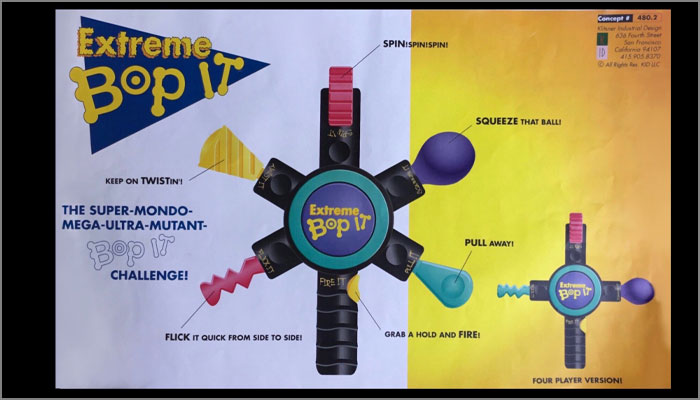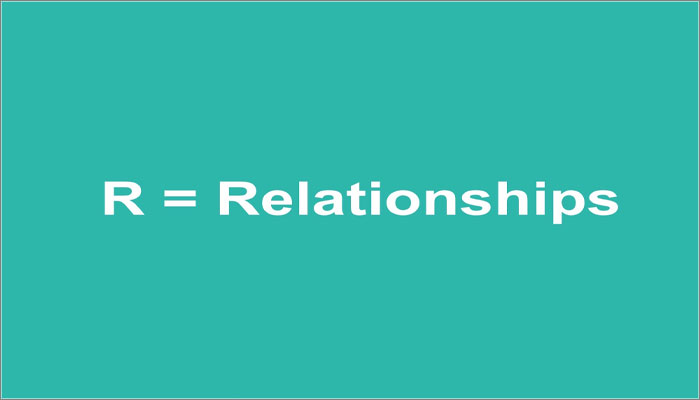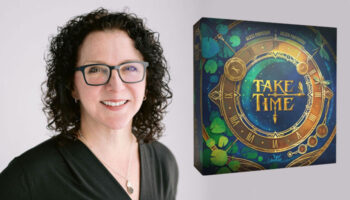Bop It’s Dan Klitsner on creative techniques, his favourite inventions and more

Serial inventor Dan Klitsner discusses RITE Ideas, Opposites, Relentless Listening – and the trap of developing variations.
Dan Klitsner! Hello again. So… In our first conversation, we more or less covered Bop It’s journey from concept to onset. This time, I want to explore a few things that sound to me like creative techniques: Opposites, Pushing Past the First Idea, Listening to Feedback… First, though, you’ve hinted at Valuing Accidents and Loving Limits in creativity. In what way do they help?
Throughout the years, I’ve found almost every limitation has in some way made the final product better. Limitations force elegance – and cost is one of the big ones that we deal with in the toy industry. I think it’s very useful to have that parameter so we use resources as efficiently as we can, and try to create products that are worth the resources used. If we had no limitations, those of us that get lost in endless brainstorming might never create anything – there would be too many possibilities.
And can you give us an example of that?
There are probably countless examples of how a limitation ended up becoming a seed of inspiration. The short story about Bop It is that – at that time – the sound chips that could be used in an electronic game at a low-enough price were very limited in size. As a result, I think the original Bop It had a total of only six seconds of sound…

Six seconds’ sound, but continuously playing?
Right; the sound is looped to create the beats and so on. As I recall, there was half-a-second of space spare in an early Bop It prototype. I believe it was Jim Tingly, a designer at Parker Brothers, that suggested the half-second be used for the words “Pass it”… Even though the original concept was to pass the game round, I actually hadn’t thought of putting the words in there. If there had been unlimited space in the chip, we probably would’ve just kept using it for more music and the like. So we may never have been forced to think “What should we do with this spare half-second of sound?”
That’s a great example! The limits force you to really consider your options.
There’s no doubt the elegance and simplicity of Bop It’s gameplay are due to there being such a limited amount of sound available. My favourite feature is that – because there wasn’t enough memory for numbers – sound effects were used to count off your score, and you had to figure it out instead of having it tell you “28”…
So the sound effects told you your score?
Right. One sound represents the ones, one sound represents tens, and there was a crazy combination of sounds when you hit 100. And when you failed, it would just start making these noises! In later Bop Its – which included more voice – we just gave the score with a number, but I kind of miss the quirkiness and elegance of the original method. There’s one other thing I’d like to say about the sound…
Go for it!
The other designer who deserves at least half the credit for having a vision for Bop It is Bob Welch – an extremely multitalented industrial designer at Parker Brothers. He was dying to do a music-based game when Bop It was brought in and, ultimately, he designed the beautiful final product, and oversaw production of all the amazing sounds. I’d always envisioned the game as having a beat to it, but in the original video I wasn’t happy with how to add it and so I left it as sounds that created the rhythm because of the time limit between each move. Bob made it all work with the right beat – and it was genius.

You’re very quick to give credit…
Well, I feel the word “inventor” is often inadequate for toy inventions – at least, where the original idea changes so much. If Bop It was a movie, I might get a credit like, ‘Based on the original short story by Dan Klitsner.’ Because, to extend that analogy, I didn’t direct the movie, or create the special effects!
A bit more than a “based on” credit, surely?! It’s still your gameplay…
Well… Yes, Bop It’s original gameplay has very much stuck with the “seed DNA” – that foamcore model – to this day… But I’m still very grateful to the many talented contributors; from my great partners Gary and Brian, to the many marketers, project managers and designers at Hasbro who have made the right decisions over the years to solidify it as a classic.
And after the initial success of Bop It, someone suggested following up with a smaller version. You did the exact opposite! You made it bigger. Why?
In the time between Bop It launching and Parker Brothers calling to ask what was next, I imagined all sorts of ways to use the “It commands: you obey” idea beyond three moves. Honestly, it was hard to stop at only five actions – I sent in sketches showing six or seven, all completely different from the original bop, twist, pull. I think it was just the natural brainstorming after realising there were so many other “Its” out there. We discussed a Bop It Pinball for example… You could go on and on and on with variations on Bop It.


But for Bop It Extreme, the plan was what?
Originally, the ideas for Bop It Extreme were that it would have four new actions and only the “bop it button” would remain from the previous one. I know after talking with Darrell Merino, though – who, by the way, was instrumental in the development of many of the Bop Its over his long career at Hasbro – that the decision was made to keep the three classic moves and just add two more. Part of this was that it’s actually more difficult than you think to come up with five very unique motions and five very unique switches. The key words here are “very unique”.
Because they have to look and feel a certain way?
Yes! There are many, many other possible types of actions – and believe me I’ve heard probably hundreds of them by now – but to be a really elegant product, you want all of them to be very unique from each other. If all of them use a downward motion with your hand for instance, it’s boring. So if you look at the original twist it and pull it, it’s hard to come up with two actions that are as unique to each other as those… So it was familiar, but made different and a lot more challenging by adding spin it and flick it.

I also want to mention that the person who was instrumental in creating Bop It Extreme was another very talented industrial designer named Curt Mahlstedt. From what I understand, he did hundreds of form studies before settling on that incredible, iconic “Zorro” Z shape which gave it an identity unique and separate from the original Bop It.
And as long as I am giving credit where it’s due to the designers at Hasbro, most of the subsequent designs were created by Dan Sanfilippo who – in my opinion – designed the most perfect blend of “industrial design meets game” when he re-imagined Bop It Extreme 2 with his beautiful fluid designs. Still my favourite of all of the Bop It designs.

So you naturally have your favourites! And as the first variation was coming together, did you like it? Or did you feel – as I think I might have – that it’s moving too far away from the three-sound idea?
Honestly, at first I didn’t like it that much compared to the original. There’s something magical about only three commands – it’s like the magic of a triangle versus a square – everything relates to itself the same way. Having a pattern of three random commands always feels kind of out of balance, and the repetition of hearing the same move over and over is actually what makes it difficult because your muscle memory, I believe, starts to anticipate a pattern.
But that changes – or you feel it changes – with five?
When there are five unique moves, your mind doesn’t hear it as a pattern so much as just a series of commands, and I think you’re less likely to make a mistake based purely on anticipation. It’s more about just reflexes. I know this is very geeky and in the weeds, but just in case you want to include that little analysis, it’s something I’ve thought about often when I watch people play and see how very different the two games really are.
Are you kidding?! I love “geeky and in the weeds”! I think it’s great to get all this detail. To me, it speaks volumes because if any one of these things was even a little bit off, Bop It might not have had the impact it had.
And on that, to mention another name that was instrumental in the Bop It years, Hasbro Games VP Dale Siswick once said, “The gameplay of the original is kind of like the bases originally being set at 90 feet apart in baseball. If they were one foot longer, or one foot shorter, the whole game would’ve changed.”

Exactly! Exactly that. So now, let me ask you this: once you’ve had a hit like Bop It or – Heaven preserve us, Perplexus; that thing drives me crazy – how do you come up with new variations?
First of all, I want to be very clear that Perplexus has a whole different creation story than any other product that KID Group has invented. We’re not the inventors of the “seed“ idea – that is the genius Michael McGinnis, who I met 23 years ago. One of my designers introduced him because he was an instructor that a friend of his had met at the junior college… He wanted talk to me about this idea he’d had since high school. He brought in a small square wooden maze made of Balsa wood that was frankly impossible for me to play!
But the one feature I liked was how you could roll the ballbearing on both sides of the track – something I’d not seen in any other ballbearing mazes before. I think what I brought to it was having a vision of how to take the very-difficult wooden mazes and turn them into a more iconic and marketable product. Along with the partners at KID Group – especially Brian Clemens – we developed the idea into what Perplexus is today…
Incredibly addictive?!
Incredibly addictive, yes! And more than that… Michael and KID Group have worked on hundreds of variations, but the original seed DNA still relates back to work Michael showed me 23 years ago.

The Perplexus saga in itself is truly a whole other article so I’ll leave it there. It’s an amazing story, with as many twists and turns as a Perplexus itself! If you’re interested in the more geeky, weedy stuff then Michael’s done a very good job of posting the whole creation story, including our meeting, and everything before and since…
Well, maybe that’s a deep dive we can do with you and Michael McGinnis in the new year…
What I believe we did together was change part of the DNA of his original seed into what we know today as the toy version of Perplexus. Continuing with the seed analogy, it’s taken 20 years of constant watering to grow that Perplexus DNA, and lots and lots of others have helped grow and shape that tree. Like I said – that’s a whole other article.
But on the subject of how you come up with new variations…
It’s hard to say what the “how” really is… Often it’s just getting fresh thinking from new people. I think I’ve always tried to do too much with a lot of the ideas, and I need to tone it down to make them simple enough so they can be produced. It’s never much of a problem of trying to think of how to do more with an idea once it’s got legs. It’s awfully fun to think of variations on something successful – much easier than coming up with something from scratch every time and hoping it makes it through the process. But there is a bit of a trap to it…
A trap? In coming up with variations?
I think so, yes. Over the years – decades actually – the amount of time that KID Group has spent on Bop It and Perplexus is well over 50% of our overhead… So it’s unclear whether it’s a good use of our time, or whether we should just let other people try to improve or create variations. However, sometimes if you just have a feel for the DNA then you’re the best to be ideating on what’s next.

And to that end, I suppose, which ideas – from the other 50% – do you think are at least as good as Bop It, but get less time in the spotlight?
I think for an idea to be truly at that level it has to break through in a classic way, and have clear space around it, and that’s pretty difficult. There are plenty of ideas that don’t have the same space around them as Bop It or Perplexus, but I still love them.
Such as?
I’d have to say the one invention that very few people even know I created is what you might refer to now as the Sand Claw. It’s an ergonomic shovel that you slip over your hand to dig in the sand. It was the very first idea that I licensed and I didn’t know what I was doing yet. It was licensed to a small company called Steven Manufacturing. I wasn’t clear on whether they were going to apply for a patent – or how that worked. I made royalties on it for about two years and then it started to get knocked off, and now I see it all over the world – so now it’s “shareware”.
Is that a difficult thing to see happen?
Well… Even though I never made royalties after that, I’m proud it’s lasted almost 30 years and has become a classic. I recently started a TikTok page and when I posted the original drawings and prototypes, people went crazy. I had no idea how many people played with it as kids and loved it. I’ve been doing some fun things about past inventions on there if you want to check it out.

And out of interest, what compelled you to share stuff on TikTok?
As part of the celebration of 25 years of Bop It, I started posting on TikTok and Instagram just to directly connect to consumers. I’m leaning heavily on the Bop It popularity at first but actually there’s just as much interest in stories about flops as there is in hits. Both have the same handle: @bopitinventor. It’s really satisfying to find fans of the products I’ve created over the years, but I’m ultimately trying to build an audience so I can figure out ways to give back for the success that Bop It has given me.
Give back in the sense…
Well, I feel so fortunate for the success that bop it has given to me, and it’s greatly due to the fact that – as a kid – I had opportunities to explore the arts that many do not. That’s why Alicia and I are launching a project called Bop It for Good; supporting kids programs in the arts and design. I started this Bop It Challenge idea on Tiktok, with people use the Bop It sounds to make a video and then bop, twist and pull a friend’s head. Or a dog’s, even!
It really took off and there are now over 100 million Bop It Challenge videos on Tiktok! Hopefully that eventually converts into people that support our Bop It for Good project. And who knows? Maybe I can sell some games direct at some point.

Great! Of which, we were talking about favourites from the other 50%…
Actually, one of my favourite games was branded as part of the Bop It line – but it really is a completely separate invention. We originally called it Cubis. It was marketed as Bop It Tetris and I believe that hurt it because it deserved to be its own game without Bop It or Tetris on it. I get lots of comments on my social media about people who have been playing it for years, and are very addicted to it; it truly combines physical and digital by having the player physically manipulating light-up squares to fit them into patterns. It uses a lot of insight from Bop It, but if it’d been marketed as its own brand I think it’d still be around today.
Interesting. I don’t know it…
In the same vein, there was another product that started out being called Light Speed… That became Bop It Smash because we licensed it to Hasbro and it was easier to put it into an existing brand. It was probably the right decision for Hasbro because of the power of the brand, but if it had been with another company I believe it could’ve been a totally separate brand with clear space around it. It really had nothing to do with Bop It! You were supposed to trap a ball of light as it passed back-and-forth through the centre by squeezing the two ends.

As discussed, though, the DNA of Bop It – in my mind – is really about audio without lights. Bop It Smash is a simple, visually-intriguing game that has potential for more longevity than Bop It in some ways because there’s no limit to the high score – and, for that reason, it was something you could always get better at – like a video game.
My other personal favourite is HyperDash which I actually invented before Bop It, and I was first exploring that same idea of “watch the player, not the game”. So it too is a game with voice commands to do physical actions. It commands you to go to a colour cup and you have to physically smash your Hyper Dash down on that colour, but you can make the game as big or small as you like.
How so?
You could make it big by spreading the different-coloured cups around the yard, or make it small by leaving them on the table. This idea was pitched to every company, several times, over a 12-year period before Wild Planet decided they wanted to get into the game business. That’s how it came out of the archives years after I started to give up on it. Like so many other ideas that just weren’t ready for what I call the “RITE“ opportunity.

Ah! Great! I’m glad you mentioned that… So you developed this acronym – R,I,T,E – and you’ve given talks on it… The idea being things have to be RITE in order to succeed. Would you walk us through that?
Sure! I’ll start with the ending of the story, though, because I’m going to ramble on how it happened, and my thoughts since. Let’s start with the visual. Think of R, I, T and E as the four legs of the table that you want to place your invention on to give it the best chance of success. The letters stand for: Relationship, Idea, Timing and Execution… They’re my original “legs of the invention evaluation table.”
Right! I’m already loving this; I’m picturing a book, but go on…
So this started when I was asked to give a talk at California College of the Arts a few years ago. I felt I wanted to give the students something to walk away with; something that they could use in their future creative professions. And all I knew was that I wanted it to be an acronym so it sounded official and easy to remember.
My guess is everyone’s familiar with the feeling that, after inventing something, it’s often easy to look back in hindsight and say “That was a perfect storm – that invention would never have succeeded if everything hadn’t been just right…” Well, that made me wonder: what did I think had to happen for the conditions to be just RIGHT? Was it possible – at the beginning or middle of the process – to help guide ideas to a successful outcome instead of just looking back on what made things “right”in hindsight?

Right spelled R,I,G,H,T? Or R,I,T,E?
I wanted it to be an easy acronym, so I decided it should only have four letters. So I spelled it R, I, T, E – still with no idea what it stood for.
And just – sorry – how long before the talk is this? A couple of weeks?
Nooooo! I only had a few hours before the talk! And honestly, I wished the word started with an “I” because I always believed “Product is king”, so the first thing you needed was a great “Idea”. However, R was the first letter so I thought to myself, “Maybe R.I.T.E. could stand for Remarkable Idea To Exploit”.
Okay! Which isn’t all that broad, is it?!
No! And my gut told me that this wasn’t a very helpful formula, and that there was more to the process than just having a good idea. I thought about all the people that need to say yes to an idea before it can fly, though, and I thought what if “Relationships” are the first thing you need? Not just that you need to know which doors to knock on, but you need to know your market, you need to know your client and the companies you’re pitching to, you need to have developed trust over time to have a champion within that company… And usually that happens from building consistent trust in relationships before just pitching someone your idea without knowing anything about them.
The more you think about it, the bigger the word Relationships gets…
It also occurred to me that you need to bounce your ideas off people you trust to give you perspective and help you brainstorm. So the R has come to mean more than just good relationships with toy companies, and to me it also stands for truly seeking out other people’s opinions. To build on that, if you have collaborators on a project, which many of us do, you need relationships with the right people with the right skill set. So over time I’ve felt that having the R first in the acronym really does work, and it symbolises that ideas just don’t come from a vacuum. You get ideas by interacting with people, understanding what they like and don’t like, being in touch with trends and so on.

Brilliant. And the I is still for Idea?
Idea, yes, although luckily it also stands for Innovation, which is different from just an idea. So the I also stands for trying to think of what you can do to your idea to bring the most innovation to it that you can. Often, we think we have a great idea and we stop short. This is a tool to help you push yourself to imagine that whatever your first idea is, you can probably innovate it to make it ten times better because you need to visualise making your table as tall as possible – taller than all the others.

Push past that first idea and keep going…
T for Timing is a very tricky one… Often people think of timing as pure luck. Sometimes it is, of course: you just happen to walk into the right place at the right time with the right idea. Lucky you! That’s something we should call “lucky timing” versus the other part of timing, which I think of as “educated timing”. As many in the toy history know, there’s a career’s worth of knowledge that goes into understanding when to pitch an idea to give it the best chance. It also means you can use the R from Relationships to help you with that…

In what way?
If you have good relationships, you can use them to help make your timing not just about luck. Spending a bit more time doing a Google search to see what’s similar in the market, whether your idea existed before you were aware of it, or whether there are trends that relate to it. All these things go under the category of timing, and they’re totally in your control.
The E is something that drives all inventors and creators crazy… Because RITE was originally for a talk to students, I wanted to impress upon them that their ability to use their skills to create the right EXECUTION was an equally important factor in any new idea. How many times have you seen an idea come out at a toy fair, or even on TV and you say “I thought of that 10 years ago” or “I pitched that exact same idea to that company!”?

Oh, absolutely; not a year passes when someone doesn’t say that at a toy fair… Sometimes with a shrug, sometimes with a grudge!
So Execution is the leg of the table that takes this into account because just having the core idea is indeed only 25% of the equation. Ten inventors could have the same basic ideas, the same relationships; and the timing for each might be perfect… But we might execute it in ten entirely different ways. So it’s really a tool to try not to get stuck on one execution of your idea. Ask yourself: are there other ways the same idea could be executed that will be better timed? And perhaps be more right for one of your relationships if you know what each of them is looking for?
Right. Right… So there’s my table, with its four legs: Relationship, Idea, Timing and Execution. How, then, do I get the most out of the table?
The way to use it to help you evaluate whether your invention is RITE, is to make sure your table has four equally-strong legs. Every invention needs to have its own table. And ideally you’d like to invest your time in the inventions that are sitting on the tallest and most evenly-supported table. So think of this as a metaphor, and a visual aid to help you reflect on what you could do to improve your chances.
It’s a way for you to say to yourself: okay… What I’m working on is a great Idea, but the other three legs are short or weak… Because then you know the table will fall over easily, so you may want to build those other legs taller to improve the chances of the idea being stable. Clearly, this isn’t a way to come up with ideas; it’s a self-evaluation tool to visualise whether you should spend time on an idea you love! Because if it sits on a very short table, one that’s crooked, it’s not as good as an idea that has better “legs” to help it through the process.
And given that you’ve licensed over 250 products – which would only be a tiny percentage of ideas that didn’t make it through the process – I’m guessing you’re no stranger to rejection. How do you cope with that?
I’d like to put this question under the category of one of my other favourite mantras: “relentless listening”. I think rejection can be spun into a positive when you see it as a gathering of information either to make your ideas better or to determine who you should pitch them to that won’t reject them.

Okay…
I know many inventors that have the same story about a product that was rejected several times, and they hadn’t given up on it… Then they show it one last time to someone new and that person goes crazy for it. Sometimes it’s just a case of right place, right time, right person. Often, though, it’s because they’ve incorporated a little bit of feedback from the other rejections.
Feedback that comes – presumably – from relentless listening?
Exactly… For relentless listening you have to be super proactive; asking the right questions when you get rejected, and determining if what you hear is helpful and should be incorporated, or should be disregarded because it’s just not the right person or company for your idea. I like to use the word relentless because it means you can’t ever just passively listen to what people say about your ideas: you really have to seek out the nuggets of feedback that make all the difference in evolving your idea to – hopefully – sell to someone else.
It sounds like you’re quite quick to modify an idea, then?
Absolutely. I think if there’s one thing that’s served me well is that I’m not too attached to my original idea if I hear some variation that improves it. I think you have to “Know it when you hear it” if it’s a better idea, and be willing to pivot instantly – no matter how much time you’ve put into your prototype already.

What’s the one question you’ve not been asked in an interview that you think would be interesting? And what’s the answer?
Never been asked what my favourite flavour of ice cream is. It’s Mint Chip.
Noted!
I also think: What drives you to create the next game? And: What’s more important to you – creating a new game that people love, or the money you might make on it?
Oh, that would be a great question! See, I wouldn’t have the nerve to ask that… But if you had to choose a reason, which reason would you choose?!
It would be a tough one because the answer is hard to separate. Part of making a lot of money on a product is because it’s a sign that it’s well-loved, and everyone wants one. But my point is that for me the thrill of inventing is what I imagine it must be like for a scientist when they discover a new species… Or explorers discover a new continent… Discovering a new game that millions of people love is kind of like discovering something no one knew existed before. In that way, it’s more important to me to be the discoverer.
Why is that, do you think? What makes that important to you?
I want to keep coming up with ideas that everyone will play – I’m always thinking there’s something better out there that will make people laugh and connect over a silly moment, and that memory will be something they talk about for years. People bond when they experience something new together for the first time – and I believe that’s why we have new games, because it’s a simple adventure they can take together.

What advice would you give people hoping to work in the industry?
Make sure you have a stomach for rejection, and that you’re driven by a passion for product such that you can’t wait to play with the things that you create. Also, show your ideas to as many companies as you can… That means building as many relationships as you can.
Finally, to that advice I’d add: make sure you love quirky people! Anytime I think about “retiring”, I can’t stand the idea of not being part of this amazing group of people and having reasons to see each other all year. I feel honoured to be part of the inventor community.
I keep asking extra questions; this is turning into an opus! As an inventor, though, I’m curious: what’s the oddest thing about your journey so far?
Oh, wow. That’s tough. I suppose the oddest things are the big surprises of seeing Bop It become part of pop culture – parodies on TV shows, for example…
Okay. There was a parody on The Simpsons, wasn’t there? And Saturday Night Live?
Yes; Saturday Night Live I think has done it three times. Funny! And there are dozens of talk-show references. It never really sinks in… But I enjoy getting all the texts when one of those moments happens – and it seems like it’s actually increasing as the generation that grew up with Bop It become parents, or celebrities for example; appearing on various talk shows or maybe become writers and work at ad agencies in mainstream media.

This might be a presumptuous question, but – having grown up with evergreen games like Mousetrap, was there a definite moment when you realised Bop It just might be one of those?
There was a time, quite early on, when I had to wonder… Ron Weingartner, then working in inventor relations for Parker Brothers / Milton Bradley, told me something. He said the head of marketing, Phil Jackson, stood up in front of everyone at a company meeting and said, “We’re witnessing the birth of a new, evergreen game brand.”

Wow. And did you dare believe that?
I dared hope it! I mean, I literally got chills at the prospect. I felt something big erupt inside me – to be connected to the history of games in that way, connected to my childhood, where the image in my mind was that my invention was going to be around for a long time – in a package with the Parker Brothers logo on it, like one of the games I played as a kid.
Great. This is just great! Listen, I’ve taken up acres of your time Dan; it’s a scandal. Let’s wrap this up with two things… Tell me, if you were going to write your autobiography, what would you call it?
How I Bopped It: A guide to Properly Annoying 100 Million Parents.
Ha! Lovely!
Maybe on the back cover it would say something like: “Always treat every idea you come up with as the best idea you’ll ever have because at some point you’ll be right.”

And you could illustrate it yourself…
Of course, something I’d want to communicate in an autobiography is that working in this industry takes having an incredibly-supportive partner. My wife Alicia has been the best sport in the world; endlessly testing out and playing games with me. But she also balances my tendency to say yes to way too many opportunities with her amazing superpower of organization. I don’t know how I’d come close to having the freedom to be as creative as I do without her amazing support.

Finally, then… What’s the most interesting thing in your office?
Probably the most interesting thing to most people is the resin “Award” shaped like a Clorox toilet-cleaning bottle… It’s from my industrial design, pre-toy-inventor days… Not just that I designed that particular bottle with the crooked neck, but that there is a resin toilet-cleaner bottle in my office among all the toys. It definitely stands out!
Brilliant. Thank you so much for your time, Dan. You realise you’ve given half your autobiography in these two interviews, don’t you?! Thank you very much for all the thought and insight in your answers. It’s been a pleasure.

—-
To stay in the loop with the latest news, interviews and features from the world of toy and game design, sign up to our weekly newsletter here





















